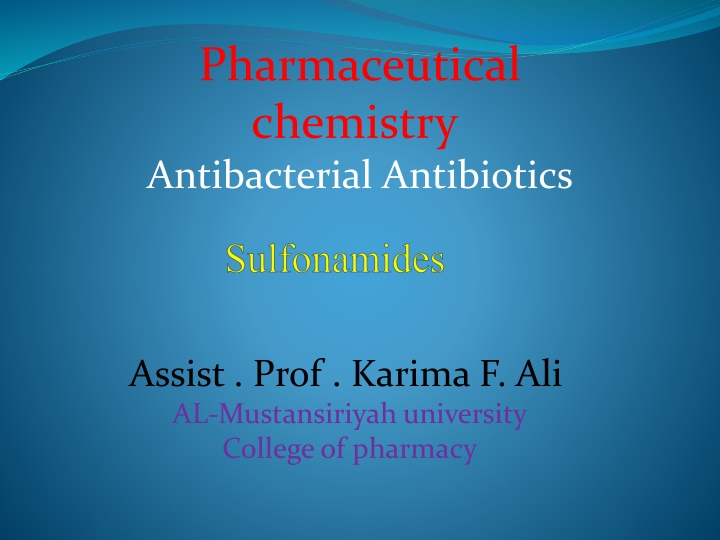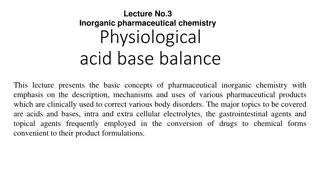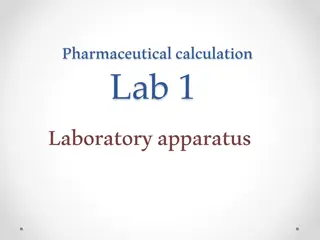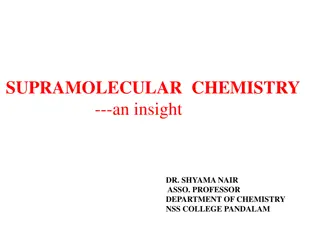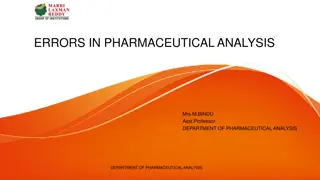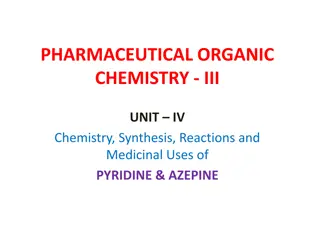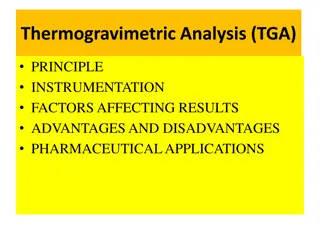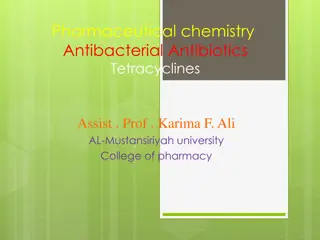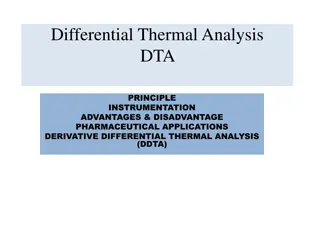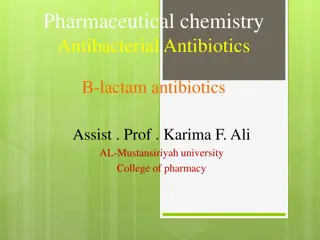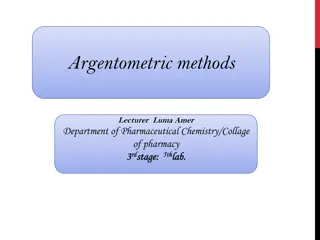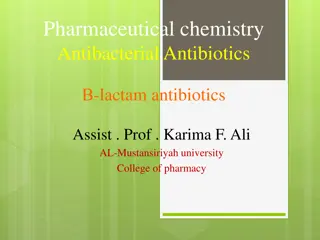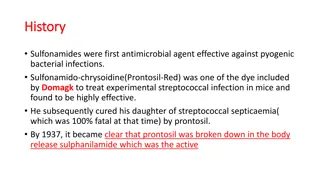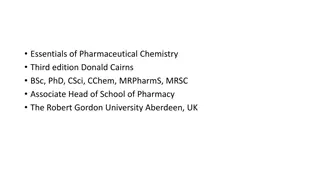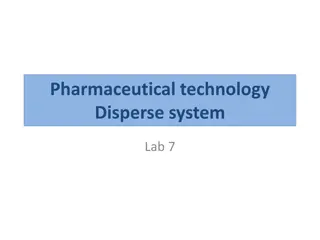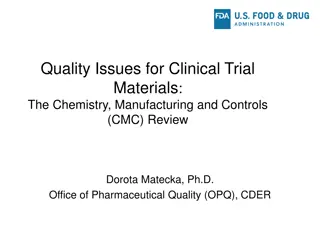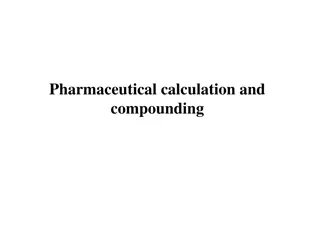Overview of Antibacterial Sulfonamides in Pharmaceutical Chemistry
Antibacterial sulfonamides were the first effective chemotherapeutic agents used systemically to cure bacterial infections in humans, leading to a decline in infectious disease morbidity. Despite rapid resistance development, they still find use in opportunistic infections, with limited applications due to broader-spectrum antibiotics. Classified into absorbable, non-absorbable, and topical agents, sulfonamides inhibit various pathogens and continue to be used in combination therapies.
Download Presentation

Please find below an Image/Link to download the presentation.
The content on the website is provided AS IS for your information and personal use only. It may not be sold, licensed, or shared on other websites without obtaining consent from the author.If you encounter any issues during the download, it is possible that the publisher has removed the file from their server.
You are allowed to download the files provided on this website for personal or commercial use, subject to the condition that they are used lawfully. All files are the property of their respective owners.
The content on the website is provided AS IS for your information and personal use only. It may not be sold, licensed, or shared on other websites without obtaining consent from the author.
E N D
Presentation Transcript
Pharmaceutical chemistry Antibacterial Antibiotics Assist . Prof . Karima F. Ali AL-Mustansiriyah university College of pharmacy
Antibacterial sulfonamides The sulfonamide antimicrobial drugs were the first effective chemotherapeutic agents that could be used systemically for the cure of bacterial infections in humans. Their introduction led to a sharp decline in the morbidity and mortality of infectious diseases. The rapid development of widespread resistance to the sulfonamides soon after their introduction and the increasing use of the broader-spectrum penicillins in the treatment of infectious disease diminished the usefulness of sulfonamides.
Today, there are a few sulfonamides and especially sulfonamide-trimethoprim combinations extensively for opportunistic infections in patients with AIDS The sulfonamides are drugs of choice for a few other types of infections, but their use is quite limited in modern antimicrobial chemotherapy. The sulfonamides can be grouped into three classes on the basis of their use: oral absorbable agents, designed to give systemic distribution; oral non absorbable agents such as sulfasalazine; and topical agents such as sodium sulfacetamide ophthalmic drops. that are used
Nomenclature of the Sulfonamides Sulfonamide is a generic term that denotes three different cases: 1. Antibacterials that are aniline-substituted sulfonamides (the sulfanilamides ). 2. Prodrugs that react to generate active sulfanilamides (i.e., sulfasalazine). 3. Non aniline sulfonamides (i.e., mafenide acetate).
There are also other commonly used drugs that are sulfonamides or sulfanilamides. Among these are the oral hypoglycemic drug tolbutamide, the diuretic furosemide, and the diuretic chlorthalidone.
Spectrum of Action of theSulfonamides Sulfonamides inhibit Gram-positive and Gram-negative bacteria, nocardia, Chlamydia trachomatis, and some protozoa. Some enteric bacteria, such as E. coli and Klebsiella, Salmonella, Shigella, and inhibited. Sulfonamides today used as combination Trimethoprim (Cotrimoxazole) as antibacterial Pyrimethamine (Cotrimazine) as anti-Malarial. Enterobacter spp. are
Topical Sulfonamides Sulfacetamide Sodium Sulfacetamide Sodium The sodium salt is highly soluble at the physiological pH of 7.4, it is especially suited, as a solution, for repeated topical applications in the local management of ophthalmic infections susceptible to sulfonamide therapy.
Non absorbable sulfonamides Topical sulfonamides for burn therapy Mafenide Acetate 4-(Amino methyl) benzene sulfonamide acetate (Sulfamylon) is a homologue of the sulfanilamide molecule. It is not a true sulfanilamide-type compound, as it is not inhibited by PABA. Its antibacterial action involves a mechanism that differs from that of true sulfanilamide-type compounds.
Sulfonamides for Intestinal Infections, Ulcerative Colitis, or Reduction of Bowel Flora sulfasalazine Each of the sulfonamides in this group is a prodrug, which is designed to be poorly absorbable, though usually, in practice, a little is absorbed. Therefore, usual precautions with sulfonamide therapy should be observed. In the large intestine, the N4-protecting groups are cleaved, releasing the free sulfonamide antibacterial agent. Today, only one example is used clinically, sulfasalazine. Sulfasalazine is broken down in the body to meta- amino salicylic acid and sulfapyridine.
Mixed Sulfonamides Trisulfapyrimidines, Oral Suspension The oral suspension of trisulfapyrimidines contains equal weights of sulfadiazine, USP; sulfamerazine, USP; and sulfamethazine, USP, either with or without an agent to raise the pH of the urine. Trisulfapyrimidines, Tablets Trisulfapyrimidine tablets contain essentially equal quantities of sulfadiazine, sulfamerazine, and sulfamethazine.
Trimethoprim Trimethoprim (5-[(3,4,5-trimethoxyphenyl)methyl]-2,4- pyrimidinediamine or 2,4-diamino-5-(3,4,5 trimethoxybenzyl) pyrimidine) is closely related to several antimalarial but does not have good antimalarial activity by itself; it is, however, a potent antibacterial. Originally introduced in combination with sulfamethoxazole, it is now available as a single agent.
